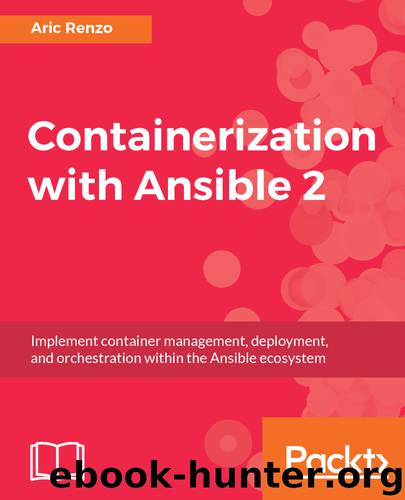Containerization with Ansible 2 by Aric Renzo

Author:Aric Renzo
Language: eng
Format: epub
Tags: COM088000 - COMPUTERS / System Administration / General, COM091000 - COMPUTERS / Cloud Computing *, COM051440 - COMPUTERS / Software Development and Engineering / Tools
Publisher: Packt
Published: 2017-12-06T11:11:00+00:00
Containers at Scale with Kubernetes
Kubernetes is by far one of the most popular open source projects to take the IT world by storm. It seems like almost everywhere you go, every blog you read, or news article you encounter, tells the tale of how Kubernetes has revolutionized the way DevOps and IT infrastructure are handled. With good reason, Kubernetes has truly taken a firm grasp of the IT landscape and introduced new concepts and ways of looking at infrastructure like no other platform before it. You might be in the camp of IT professionals who have heard of Kubernetes, but you have no idea what it is or how it can really benefit your infrastructure. Or, you could be where most of us are today, in the process of containerizing applications and workloads but don’t want to dabble in the additional complexity and murky water of Kubernetes just yet. Finally, you could be one of those lucky DevOps engineers or IT administrators who have successfully adopted containers and Kubernetes and is able to really reap the reliability and flexibility that Kubernetes provides.
The purpose of this chapter is to provide an overview of what Kubernetes is, how it works (at a high level), and how to deploy your containerized applications to Kubernetes clusters using Ansible Container. Before we dive in too deep, you might ask, what is Kubernetes exactly? Kubernetes is a platform developed by Google for deploying, managing, configuring, and orchestrating containers at both small and large scales. Kubernetes was started as an internal project at Google, known as Borg, for managing the automatic deployment and scaling of containers across the vast Google infrastructure footprint. Based on some real-world lessons learned with Borg, Google released Kubernetes as an open source project so that other users and organizations could leverage the same flexibility to deploy containers at scale. Using Kubernetes, one can easily run containerized applications across multiple clustered nodes, automatically maintaining the desired number of replicas, service endpoints, and loadbalancing across the cluster.
Throughout this book, we have looked closely at how we can use the Ansible Container platform to quickly and reliably build container images using Ansible Playbooks and run those containers on our local workstation. Since we now understand quite well how to build version control and configuration management inside of our containers, the next step is using configuration management to declare how our applications should run outside of our container. This is the gap that Kubernetes fills. And, yes, it is just as awesome as it sounds. Ready? Let’s get started.
Throughout this chapter, we will cover:
A brief overview of Kubernetes
Getting started using Google Cloud Engine
Deploying an application in Kubernetes using kubectl
Writing a Kubernetes manifest
Deploying and updating containers in Kubernetes
Download
This site does not store any files on its server. We only index and link to content provided by other sites. Please contact the content providers to delete copyright contents if any and email us, we'll remove relevant links or contents immediately.
Grails in Action by Glen Smith Peter Ledbrook(9163)
Sass and Compass in Action by Wynn Netherland Nathan Weizenbaum Chris Eppstein Brandon Mathis(8808)
Azure Containers Explained by Wesley Haakman & Richard Hooper(7444)
Configuring Windows Server Hybrid Advanced Services Exam Ref AZ-801 by Chris Gill(7433)
Kotlin in Action by Dmitry Jemerov(7263)
Running Windows Containers on AWS by Marcio Morales(6984)
Microsoft 365 Identity and Services Exam Guide MS-100 by Aaron Guilmette(5402)
Microsoft Cybersecurity Architect Exam Ref SC-100 by Dwayne Natwick(5212)
Combating Crime on the Dark Web by Nearchos Nearchou(4982)
The Ruby Workshop by Akshat Paul Peter Philips Dániel Szabó and Cheyne Wallace(4671)
Management Strategies for the Cloud Revolution: How Cloud Computing Is Transforming Business and Why You Can't Afford to Be Left Behind by Charles Babcock(4527)
Python for Security and Networking - Third Edition by José Manuel Ortega(4233)
The Age of Surveillance Capitalism by Shoshana Zuboff(4209)
Learn Wireshark by Lisa Bock(4123)
The Ultimate Docker Container Book by Schenker Gabriel N.;(3888)
Learn Windows PowerShell in a Month of Lunches by Don Jones(3681)
DevSecOps in Practice with VMware Tanzu by Parth Pandit & Robert Hardt(3568)
Windows Ransomware Detection and Protection by Marius Sandbu(3543)
Blockchain Basics by Daniel Drescher(3507)
